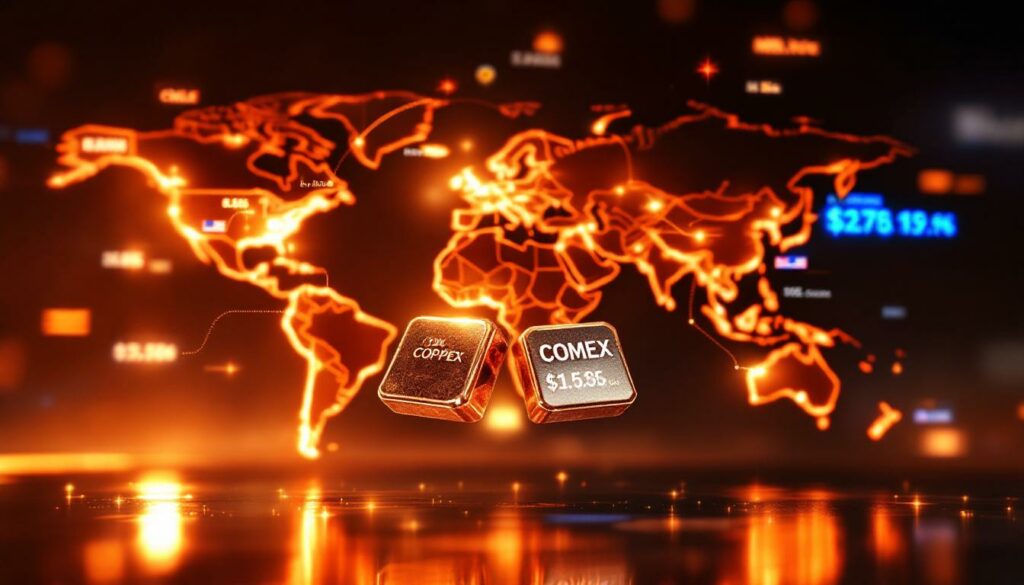The Looming Copper Tariff Crisis: Understanding the Situation
Recent Tariff Announcements and Their Immediate Impact
The global copper market has been thrown into unprecedented turmoil following the announcement of potential 50% tariffs on copper imports to the United States, scheduled to take effect August 1, 2025. This significant policy shift under the Trump administration has triggered exceptional market volatility, with copper prices on the COMEX experiencing their largest single-day increase in history—jumping $0.66/lb to reach $5.65/lb immediately following the announcement.
Market analysts have noted that such dramatic price movements signal not just immediate reactions but deeper concerns about long-term supply security and cost structures across multiple industries dependent on copper inputs.
"The proposed tariffs have already increased the price for copper, regardless of whether they're eventually implemented," notes Steve Fiscor, Editor of Engineering & Mining Journal. "How this will help American consumers remains a mystery when examining the broader economic impacts."
Current Market Response and Stockpiling Behavior
The threat of impending tariffs has sparked a dramatic surge in copper stockpiling activities across the United States. Data compiled by The Copper Journal shows that copper held in COMEX warehouses has increased by an astounding 203,531 metric tons—from just 8,936 metric tons last year to 212,467 metric tons in recent weeks.
Even more remarkably, this represents only a fraction of the total influx, as nearly 740,000 metric tons have arrived in the U.S. over the past three months alone. Additional shipments remain en route as importers race to beat the August deadline.
Industry experts point out that this stockpiling behavior creates artificial market conditions:
- Short-term scarcity in global markets outside the U.S.
- Price premiums in regions experiencing supply constraints
- Potential for future market collapse when stockpiles eventually return to circulation
- Warehouse capacity constraints at major ports and logistics hubs
The COMEX warehouse reporting system, which tracks these inventories, has become an increasingly watched metric as it provides real-time insights into how rapidly material is accumulating ahead of the tariff deadline.
Why Are Copper Tariffs Being Considered?
Strategic Goals Behind the Tariff Policy
The stated objective behind these potential tariffs is to build a "dominant copper industry" within the United States. This approach aligns with broader economic nationalism policies that aim to reduce dependency on foreign suppliers and stimulate domestic production capacity.
Industry experts, however, question whether tariffs represent the most effective path toward this goal, particularly given the complex nature of developing new copper refining capacity:
- Capital intensity: New copper smelters typically require $500 million to $1 billion in investment
- Development timeline: From planning to commissioning typically spans 5-7 years
- Regulatory hurdles: Environmental permitting alone can take 2-3 years even with expedited processes
- Technical expertise: Specialized workforce development needs that cannot be rapidly addressed
"Even with accelerated permitting, building new smelting capacity is unlikely to be accomplished within a single presidential term," notes industry analysis from E&MJ. "The disconnect between political timelines and industrial development realities creates fundamental policy challenges."
Geopolitical Dimensions of Copper Trade Policy
While initial analysis might suggest these tariffs target China, which produces over 40% of the world's refined copper, the reality is more complex and nuanced. U.S. copper imports primarily originate from Chile (65%), Canada (17%), and Mexico (9%), according to the latest U.S. Geological Survey data.
This import profile raises significant questions about the strategic alignment of the tariff policy with actual trade flows and geopolitical objectives. Rather than primarily affecting Chinese producers, the tariffs would most heavily impact long-standing trading partners in the Americas, potentially straining diplomatic and economic relationships.
The policy also creates paradoxical situations where allied nations with free trade agreements may face substantial new barriers for copper exports to the U.S., despite decades of integrated supply chain development.
How Will Tariffs Affect Copper Supply Chains?
U.S. Copper Import Dependencies
The United States relies heavily on imported refined copper, with a supply chain that has developed over decades of globalized trade and specialized production. The current import profile reveals that despite China's dominance in global copper refining, U.S. copper supplies come predominantly from the Americas.
Chile alone provides nearly two-thirds of all refined copper imports to the United States, creating a particularly vulnerable dependency should tariffs disrupt this trading relationship. Chilean producers like Codelco, Antofagasta, and Anglo American would face significant challenges adapting to a 50% tariff barrier.
Key logistics considerations further complicate the picture:
- Port capacity constraints at major U.S. entry points
- Transportation bottlenecks for inland movement of stockpiled material
- Warehousing costs and financing requirements for extended storage
- Quality degradation concerns for long-term stored copper cathodes
Potential Market Disruptions and Price Volatility
Market analysts anticipate significant disruptions if tariffs are implemented as planned. The current stockpiling behavior is creating artificial scarcity in some markets while potentially setting the stage for a price collapse when these warehoused supplies eventually return to the market.
This volatility creates substantial planning challenges for industries dependent on copper, from construction to electronics manufacturing. Procurement teams across these sectors face difficult decisions about whether to secure supply at current elevated prices or risk potential shortages if tariffs proceed as planned.
Three distinct market scenarios have emerged in analyst projections:
- Price divergence: U.S. domestic copper prices could trade at substantial premiums to global benchmarks, creating arbitrage opportunities
- Smuggling concerns: History suggests high-value materials facing significant tariffs become targets for customs circumvention
- Supply chain reconfiguration: Manufacturing could shift to regions with lower copper input costs to maintain competitive finished goods pricing
What Are the Economic Implications of Copper Tariffs?
Consumer Impact and Downstream Effects
The immediate effect of tariff threats in copper markets has been higher copper prices, which will inevitably be passed on to consumers across multiple sectors. Industries that rely heavily on copper face increased production costs that could slow growth and potentially accelerate inflation.
Particularly vulnerable sectors include:
- Construction: Electrical wiring, plumbing, and HVAC systems
- Electronics: Circuit boards, semiconductors, and connectors
- Automotive: Traditional and electric vehicle wiring harnesses
- Renewable energy: Solar installations, wind turbines, and grid infrastructure
- Telecommunications: Broadband infrastructure and data centers
For context, a typical electric vehicle contains approximately 180 pounds of copper—nearly four times the amount in conventional vehicles. The green energy transition depends heavily on copper availability at economical prices, making tariff impacts particularly consequential for climate goals.
Long-term Investment Considerations
While tariffs might temporarily boost domestic copper producers through higher pricing, the long-term investment landscape becomes significantly more uncertain. The development of new copper smelting capacity requires substantial capital investment and multi-year planning horizons.
Investors may hesitate to commit resources to projects that could become uneconomical if tariff policies change with future administrations. This policy uncertainty potentially undermines the very goal of building domestic copper capacity by introducing risk premiums into investment calculations.
Industry experts suggest that more effective approaches to stimulating domestic production might include:
- Investment tax credits specifically targeting copper refining capacity
- Streamlined permitting while maintaining environmental protections
- Workforce development programs focused on metallurgical expertise
- Research funding for more efficient extraction and refining technologies
- Long-term purchasing agreements from government agencies
How Are Global Copper Producers Responding?
Strategic Positioning of Major Copper Companies
Major copper producers are adopting varied approaches to the tariff threat, balancing short-term tactics with long-term strategic considerations. Codelco's chairman, Máximo Pacheco, has publicly taken a measured "wait-and-see" stance, acknowledging that drawing conclusions three weeks before the deadline would be premature.
"It's too soon to draw conclusions," Pacheco noted in comments reported by industry sources. This reflects the industry's experience with policy volatility and the need for strategic patience when navigating geopolitical uncertainties.
Other major producers are reportedly exploring:
- Geographic diversification of refining operations
- Contractual adjustments to shift tariff burdens
- Potential for processing intermediates (like copper concentrates) rather than refined copper
- Partnership structures that might qualify for tariff exemptions
Alternative Approaches to Building Domestic Capacity
Industry experts suggest that rather than implementing tariffs, a more effective approach to building domestic copper capacity would involve incentivizing the construction of new smelters through investment tax credits, streamlined permitting, and other supportive policies.
The current administration has demonstrated an ability to accelerate mining permits, but smelter development represents a different and more complex challenge, involving:
- More stringent air quality requirements
- Higher capital intensity and longer payback periods
- Specialized technical workforce requirements
- More complex logistics networks for inputs and outputs
Comparative analysis with other metals sectors suggests that incentive-based approaches rather than trade barriers typically yield more sustainable US copper investment insight.
What Are the Contradictions in Current Copper Policy?
The Lobito Railway Paradox
An apparent contradiction in current policy involves continued U.S. funding for the Lobito Railway—an infrastructure project connecting copper mines in the Democratic Republic of Congo and Zambia to Angola's Atlantic port of Lobito.
This investment effectively reduces transportation costs for international copper producers, including Chinese and Canadian companies, seemingly at odds with the goal of building domestic copper dominance. The railway project will make African copper more competitive in global markets, potentially working against U.S. producers.
As Steve Fiscor points out in Engineering & Mining Journal: "The U.S. is currently funding the Lobito Railway project that will effectively reduce transportation costs for Chinese companies like Zijin and Canadian firms like Ivanhoe." This creates a policy contradiction that challenges the coherence of the broader strategy.
Balancing Short-term Politics and Long-term Industry Development
The tension between immediate political objectives and the long-term development needs of the copper industry creates policy inconsistencies. Building domestic smelting capacity requires years of planning and construction, making it unlikely that any new facilities could be commissioned within a single presidential term, regardless of regulatory support.
This misalignment between political and industrial timelines creates implementation challenges:
- Policy uncertainty discouraging long-term capital commitments
- Difficulty maintaining consistent regulatory approaches across administrations
- Potential for stranded assets if policies shift during development cycles
- Disruption of established supply relationships without viable alternatives
What Happens If Tariffs Are Implemented?
Potential Market Scenarios and Price Projections
If tariffs are implemented as threatened, several market scenarios could unfold:
-
Price Spike Scenario: U.S. copper prices could rise significantly above global benchmarks, creating arbitrage opportunities and incentivizing smuggling or misclassification of imports
-
Supply Diversion Scenario: Global copper flows could reorganize, with non-U.S. markets absorbing copper previously destined for American consumers
-
Stockpile Release Scenario: The eventual release of accumulated warehouse stocks could trigger a price collapse, harming both domestic and international producers
-
Manufacturing Relocation Scenario: Copper-intensive manufacturing could shift to jurisdictions with lower input costs, potentially accelerating offshoring trends
The magnitude of these effects would depend on implementation details, including potential exemptions for certain trading partners or specific copper product categories.
Industry Adaptation Strategies
Copper-dependent industries are developing contingency plans that include:
- Securing long-term supply contracts before tariff implementation
- Exploring substitute materials where technically feasible
- Relocating manufacturing to jurisdictions with lower copper input costs
- Passing increased costs to end consumers where market conditions permit
- Developing technical specifications that might qualify for tariff exemptions
- Investigating recycling and urban mining alternatives
How Might the Copper Tariff Situation Resolve?
Potential Policy Outcomes and Timelines
Several potential resolutions to the current situation exist:
- Full implementation of the threatened 50% tariff
- Scaled-back implementation with lower tariff rates or exemptions for certain trading partners
- Delayed implementation pending further industry consultation
- Complete withdrawal of the tariff threat
- Replacement with alternative policies to incentivize domestic production
Given the complexity of global supply chains and diplomatic considerations, industry analysts suggest that modifications to the initial proposal remain possible as the August 2025 deadline approaches.
Market Recovery Expectations
If the tariff threat proves to be temporary, markets could experience a period of adjustment as accumulated stockpiles are gradually absorbed. This would likely create downward price pressure, potentially harming future investment in copper production capacity—the opposite effect of what tariff proponents seek to achieve.
Recovery timelines would depend on:
- The volume of accumulated inventory
- Demand growth in copper-intensive sectors
- Alternative market development for previously U.S.-bound material
- Producer responses, including potential production curtailments
FAQs About Copper Tariffs and Market Impacts
What industries would be most affected by copper tariffs?
Construction, electronics manufacturing, automotive production, and renewable energy sectors would face the most significant impacts from copper tariffs, as these industries rely heavily on copper for essential components and infrastructure.
The telecommunications sector would also experience substantial challenges, particularly with ongoing 5G network deployments requiring significant copper inputs for both equipment and infrastructure.
How do copper tariffs affect the green energy transition?
Copper is essential for renewable energy systems, electric vehicles, and grid modernization. Higher copper prices resulting from tariffs could slow the pace of green energy adoption by increasing installation costs for solar arrays, wind farms, and EV charging infrastructure.
For context, renewable energy systems typically require 4-5 times more copper per megawatt than traditional power generation. A utility-scale solar installation uses approximately 9,000 pounds of copper per megawatt, making price fluctuations particularly impactful for project economics.
Could domestic copper production realistically replace imports?
While the U.S. has substantial copper resources, developing the mining and especially the smelting capacity to replace imports would require years of development and billions in investment. Even with accelerated permitting, building a self-sufficient copper supply chain would be a multi-decade project.
Current U.S. mine production satisfies only about 25% of domestic demand, with the remainder coming from imports and recycling. Closing this gap would require not just mine development but significant investments in smelting and refining capacity, which have historically migrated to regions with lower energy costs and less stringent environmental regulations.
What alternatives exist to tariffs for strengthening domestic copper production?
More effective alternatives might include:
- Investment tax credits for new smelting facilities
- Research funding for more efficient extraction technologies
- Workforce development programs for mining specialists
- Streamlined environmental permitting while maintaining ecological safeguards
- Government procurement preferences for domestically produced copper
- Public-private partnerships for demonstration projects
- Recycling incentives to increase domestic copper recovery rates
Navigating Uncertainty in Copper Markets
The copper market finds itself at a crossroads, with potential tariffs creating significant uncertainty for producers, consumers, and investors alike. While the stated goal of building domestic copper capacity has merit, the chosen policy approach raises questions about effectiveness and unintended consequences.
For now, industry leaders like Codelco's Pacheco are taking a measured approach, recognizing that policy announcements don't always translate directly to implementation. Market participants must prepare for multiple scenarios while hoping for policy clarity that supports stable, sustainable development of global copper resources.
The contradiction between the Lobito Railway investment and copper tariff proposals highlights the complex balancing act between geopolitical objectives, industrial policy, and global trade relationships. As the August 2025 deadline approaches, market participants will be watching closely for signals about potential modifications or clarifications to the tariff proposal.
In addition, investors should pay close attention to the potential impact on ASX copper stocks and examine copper price predictions from industry experts. Furthermore, understanding the global copper supply forecast and surging copper demand will be crucial for navigating these uncertain market conditions.
Further Exploration:
Readers interested in learning more about copper market dynamics and trade policy impacts can also explore related educational content from industry publications such as Engineering & Mining Journal, which regularly covers developments in global copper markets.
Looking to Capitalize on Future Copper Discoveries?
Discovery Alert's proprietary Discovery IQ model provides instant notifications when significant mineral discoveries are announced on the ASX, turning complex data into actionable investment insights. Visit the Discovery Alert discoveries page to understand how major mineral discoveries can generate substantial returns for informed investors.




